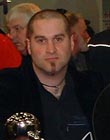|
|
This topic comprises 3 pages: 1 2 3
|
|
Author
|
Topic: curved gates - why?
|
|
|
|
|
John Pytlak
Film God

Posts: 9987
From: Rochester, NY 14650-1922
Registered: Jan 2000
|
 posted 10-24-2002 08:40 AM
posted 10-24-2002 08:40 AM





Curved gates really help maintain focus stability as power levels increase. Several technical papers published in the SMPTE Journal years ago by Willy Borberg of General Precision Laboratory, and E. K. Carver, Fred Kolb and Paul Preo of Kodak, led to the development of curved projector gates.By gently curving the film, the print is more resistant to flexing and changing focus position as it is heated by the intense focused energy of the lamphouse. ------------------
John P. Pytlak, Senior Technical Specialist
Worldwide Technical Services, Entertainment Imaging
Research Labs, Building 69, Room 7525A
Rochester, New York, 14650-1922 USA
Tel: +1 585 477 5325 Cell: +1 585 781 4036 Fax: +1 585 722 7243
e-mail: john.pytlak@kodak.com
Web site: http://www.kodak.com/go/motion
| IP: Logged
|
|
|
|
Pat Moore
Master Film Handler

Posts: 363
Registered: Mar 2000
|
 posted 10-24-2002 01:49 PM
posted 10-24-2002 01:49 PM




It is a variable thing, Jack, with all that mentioned in the mix and more. We built 870 projectors with air stabilization on that very large frame of film. The trap was compound -- curved above and below the aperture, but flat in the image area because the lens needed a flat plane to focus on.In general, though, I think the curved gate and trap is the simplest and most effective method of controlling the tendency of film to flex in normal theatre operations. Modern lenses are design with that field curvature in mind. Heat is probably the second biggest influence affecting focus quality. Pat
| IP: Logged
|
|
|
|
John Pytlak
Film God

Posts: 9987
From: Rochester, NY 14650-1922
Registered: Jan 2000
|
 posted 10-24-2002 03:28 PM
posted 10-24-2002 03:28 PM





Perhaps Dwight Lindsey of Schneider, or someone from Isco can jump in here. AFAIK, a lens can be designed assuming EITHER a perfectly flat film plane, or some film curvature. I recall that one of the reasons modern lenses are so much better than those of a few decades ago is the recognition that the film is NOT perfectly flat at the moment of projection. ------------------
John P. Pytlak, Senior Technical Specialist
Worldwide Technical Services, Entertainment Imaging
Research Labs, Building 69, Room 7525A
Rochester, New York, 14650-1922 USA
Tel: +1 585 477 5325 Cell: +1 585 781 4036 Fax: +1 585 722 7243
e-mail: john.pytlak@kodak.com
Web site: http://www.kodak.com/go/motion
| IP: Logged
|
|
|
|
Steve Guttag
We forgot the crackers Gromit!!!

Posts: 12814
From: Annapolis, MD
Registered: Dec 1999
|
 posted 10-24-2002 05:20 PM
posted 10-24-2002 05:20 PM




I'll go round and round on the "flat-field" issue... First off...as the film is heated in the aperture...it swells towards the light source so even with a straight gate, the film is not flat. Furthermore, as the film is pumped by the shutter (it's on and its off...) the film is in in constant motion fore and aft. The relaxation of the film between the shutter and flicker cycle is not enough for the film to completely relax. With 3-blade shutters this can be even worse since the film is hit three times and the film is actually moving to different extremes each time. It is easy to see that with higher wattages, the effects become more noticable. Many screening room projectors are still straight gate to this day. Since they are in the 500-1000 watt range, the heat really isn't an issue. Order a Simplex PR-1020 and see what you get. Studio gates also have overlapping pad areas. Curving the gate stretches the film and controls it a bit better. In fact, VistaVision really has it best since it curves the film on the long direction. Steve ------------------
"Old projectionists never die, they just changeover!"
| IP: Logged
|
|
|
|
|
|
|
|
|
|
|
|
|
|
|
|
All times are Central (GMT -6:00)
|
This topic comprises 3 pages: 1 2 3
|
Powered by Infopop Corporation
UBB.classicTM
6.3.1.2
The Film-Tech Forums are designed for various members related to the cinema industry to express their opinions, viewpoints and testimonials on various products, services and events based upon speculation, personal knowledge and factual information through use, therefore all views represented here allow no liability upon the publishers of this web site and the owners of said views assume no liability for any ill will resulting from these postings. The posts made here are for educational as well as entertainment purposes and as such anyone viewing this portion of the website must accept these views as statements of the author of that opinion
and agrees to release the authors from any and all liability.
|

 Home
Home
 Products
Products
 Store
Store
 Forum
Forum
 Warehouse
Warehouse
 Contact Us
Contact Us




 Printer-friendly view of this topic
Printer-friendly view of this topic










 ) of the lens, thus minimizing the phenomena where the center of the picture is in focus but not the edges, or vice-versa.
) of the lens, thus minimizing the phenomena where the center of the picture is in focus but not the edges, or vice-versa.










